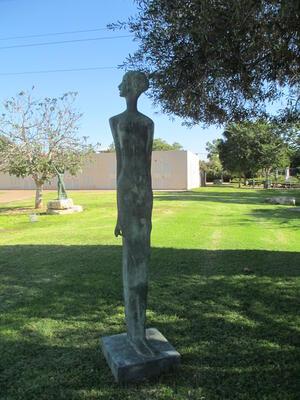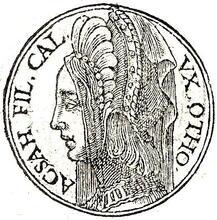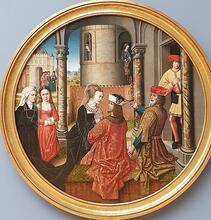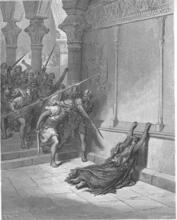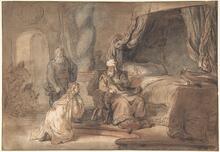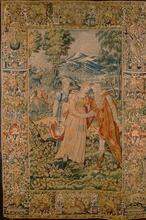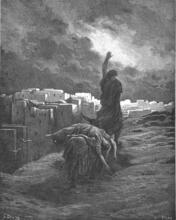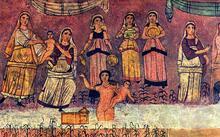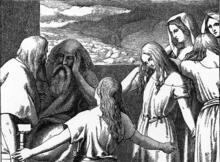Lot's Wife: Midrash and Aggadah
Lot’s wife, known to the Rabbis as Idit, was rescued from the upheaval of Sodom. Jealous of others, however, she did not want to offer hospitality to guests. When she goes to her women neighbors for salt to give her husband’s guests, she makes it known to the town that Lot is harboring guests. The townspeople storm Lot’s house and remove his guests. Lot’s wife sinned thus through salt, and for this she is turned into a pillar of salt.
Idit’s Story
The Bible does not mention Lot’s wife by name, but the Rabbis referred to her as “Idit” (Tanhuma [ed. Buber], Vayera 8). This woman’s sorry end teaches of her life: even though she was rescued from the upheaval of Sodom, she was stricken together with the other inhabitants of the city, from which the Rabbis conclude that her actions, as well, were no different from those of the rest of Sodom’s populace. Jealous of others, she offered no hospitality to guests. The angels did not initially want to be her guests, but rather those of her husband Lot, since he was more righteous (Num. Rabbah 10:5); she even tried to bar their entry to the house. Lot’s wife divided their house into two parts and told her husband: “If you want to receive them, do so in your part” (Gen. Rabbah 50:6). Lot wanted the members of his household to participate in the meritorious act of hospitality, as had Abraham, and he asked his wife to bring them salt. She responded: “Do you even wish to learn this bad habit from Abraham?” (Gen. Rabbah 50:4). She finally complied with her husband’s request, but she acted cunningly in order to remove the guests from her house. She went to her women neighbors to borrow salt. They asked her: “Why do you need salt, why didn’t you prepare enough beforehand?” She answered, “I took enough for our own needs, but guests came to us and it is for them that I need salt.” In this manner all the people of Sodom knew that Lot was harboring guests. They stormed his house and demanded that he hand them over to the townspeople (Midrash Aggadah [ed. Buber], Gen. 19:26). Because she sinned through salt, Lot’s wife was punished by being turned into a pillar of the same material (Gen. Rabbah 51:5).
Why Salt?
Another explanation for Lot’s wife being transformed into a pillar of salt is based on her having four daughters, two married and two betrothed. The two married daughters and their husbands remained in the doomed city, as did her two future sons-in-law (Gen. Rabbah 50:9; see also “Lot’s Daughters”). When Lot and his wife were saved from the destruction of the city, she took pity on her married daughters who had remained in Sodom and looked behind her. As soon as she saw the back of the Shekhinah (Divine Presence), she was transformed into a pillar of salt (Pirkei de-Rabbi Eliezer, ed. Higger, chap. 25).
Aggadah Commentary
The pillar of salt was left by God as a memorial for all time (Yalkut Shimoni on Esth., para. 1056). Moses saw the pillar of Lot’s wife when God showed him all the land of Canaan before his death (Mekhilta de-Rabbi Ishmael, Masekhta de-Amalek, Beshalah 2). Anyone who sees Lot’s wife is required to recite two blessings. The first, “Blessed be the One who remembers the righteous,” expresses thanksgiving and praise to God for having remembered Abraham, by the merit of whose righteousness He saved Lot and his wife from the upheaval; this blessing relates to the miracle that was performed for Lot. The second blessing, “Blessed be the true Judge” (that is recited upon hearing of someone’s death), is recited for the punishment visited on Lot’s wife (BT Berakhot 54a–b). A late Statements that are not Scripturally dependent and that pertain to ethics, traditions and actions of the Rabbis; the non-legal (non-halakhic) material of the Talmud.aggadah relates that Lot’s wife stands in her place to the present; every day passing oxen lick her feet and every morning she rises once again to her previous shape as a pillar of salt (Sefer ha-Yashar, Vayera 39).
Hyman, Naomi. Biblical Women in the Midrash: A Sourcebook. Northvale, N.J.: Jason Aronson, Inc, 1997.

